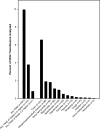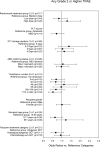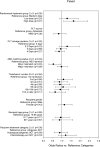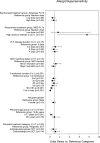Transfusion-related adverse events in the Platelet Dose study
- PMID: 25065959
- PMCID: PMC4293226
- DOI: 10.1111/trf.12791
Transfusion-related adverse events in the Platelet Dose study
Abstract
Background: How platelet (PLT) product characteristics such as dose, source (whole blood derived [WBD] vs. apheresis), storage duration, and ABO matching status affect the risks of transfusion-related adverse events (TRAEs) is unclear. Similarly, more information is needed to define how recipient characteristics affect the frequency of TRAEs after PLT transfusion.
Study design and methods: In the multicenter Platelet Dose ("PLADO") study, pediatric and adult hematology-oncology patients with hypoproliferative thrombocytopenia were randomized to receive low-dose (LD), medium-dose (MD), or high-dose (HD) PLT prophylaxis for a pretransfusion PLT count of not more than 10 × 10(9) /L. All PLT units (apheresis or WBD) were leukoreduced. Post hoc analyses of PLADO data were performed using multipredictor models.
Results: A total of 5034 PLT transfusions to 1102 patients were analyzed. A TRAE occurred with 501 PLT transfusions (10.0%). The most common TRAEs were fever (6.6% of transfusions), allergic or hypersensitivity reactions (1.9%), and sinus tachycardia (1.8%). Patients assigned HD PLTs were more likely than LD or MD patients to experience any TRAE (odds ratio for HD vs. MD, 1.50; 95% confidence interval, 1.10-2.05; three-group comparison p = 0.02). PLT source and ABO matching status were not significantly related to overall TRAE risk. Compared to a patient's first PLT transfusion, subsequent PLT transfusions were less likely to have a TRAE reported, primarily due to a lower risk of allergic or hypersensitivity reactions.
Conclusion: The most important PLT unit characteristic associated with TRAEs was PLT dose per transfusion. HD PLTs may increase the risk of TRAEs, and LD PLTs may reduce the risk.
© 2014 AABB.
Conflict of interest statement
Conflicts of interest: Darrell J. Triulzi is on the medical advisory board for Fenwal Fresenius Kabi. Paul Ness is a consultant for TerumoBCT, Lakewood, CO. The remaining authors declare no conflicts of interest.
Figures





References
-
- Slichter SJ, Kaufman RM, Assmann SF, McCullough J, Triulzi DJ, Strauss RG, Gernsheimer TB, Ness PM, Brecher ME, Josephson CD, Konkle BA, Woodson RD, Ortel TL, Hillyer CD, Skerrett DL, McCrae KR, Sloan SR, Uhl L, George JN, Aquino VM, Manno CS, McFarland JG, Hess JR, Leissinger C, Granger S. Dose of prophylactic platelet transfusions and prevention of hemorrhage. N Engl J Med. 2010;362:600–13. - PMC - PubMed
-
- Miller AB, Hoogstraten B, Staquet M, Winkler A. Reporting results of cancer treatment. Cancer. 1981;47:207–14. - PubMed
-
- Zelen M. The randomization and stratification of patients to clinical trials. J Chronic Dis. 1974;27:365–75. - PubMed
-
- Common Terminology Criteria for Adverse Events (CTCAE), version 3.0. Available from http://ctep.cancer.gov/protocolDevelopment/electronic_applications/docs/.... - PubMed
-
- Lindstrom MJ, Bates DM. Newton-Raphson and EM Algorithms for Linear Mixed Effects Models for Repeated Measures Data. JASA. 1988;83:1014–21.
Publication types
MeSH terms
Substances
Grants and funding
- U01 HL072346/HL/NHLBI NIH HHS/United States
- HL072290/HL/NHLBI NIH HHS/United States
- U01 HL072291/HL/NHLBI NIH HHS/United States
- HL072331/HL/NHLBI NIH HHS/United States
- HL072033/HL/NHLBI NIH HHS/United States
- HL072274/HL/NHLBI NIH HHS/United States
- HL072248/HL/NHLBI NIH HHS/United States
- HL072305/HL/NHLBI NIH HHS/United States
- U01 HL072274/HL/NHLBI NIH HHS/United States
- U01 HL072355/HL/NHLBI NIH HHS/United States
- U01 HL072359/HL/NHLBI NIH HHS/United States
- U01 HL072248/HL/NHLBI NIH HHS/United States
- HL072299/HL/NHLBI NIH HHS/United States
- U01 HL072191/HL/NHLBI NIH HHS/United States
- U01 HL072033/HL/NHLBI NIH HHS/United States
- U01 HL072268/HL/NHLBI NIH HHS/United States
- U01 HL072305/HL/NHLBI NIH HHS/United States
- U01 HL072028/HL/NHLBI NIH HHS/United States
- HL072268/HL/NHLBI NIH HHS/United States
- HL072196/HL/NHLBI NIH HHS/United States
- HL072283/HL/NHLBI NIH HHS/United States
- HL072191/HL/NHLBI NIH HHS/United States
- U01 HL072290/HL/NHLBI NIH HHS/United States
- HL072346/HL/NHLBI NIH HHS/United States
- U01 HL072283/HL/NHLBI NIH HHS/United States
- U01 HL072299/HL/NHLBI NIH HHS/United States
- U01 HL072331/HL/NHLBI NIH HHS/United States
- HL072291/HL/NHLBI NIH HHS/United States
- U01 HL072196/HL/NHLBI NIH HHS/United States
- HL072028/HL/NHLBI NIH HHS/United States
LinkOut - more resources
Full Text Sources
Other Literature Sources
Medical
Research Materials

